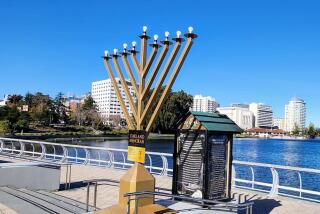People of the Book : New Ritual Helps Revive Judaic Tradition of Burying Worn-Out Sacred Texts
- Share via
Each bearing a worn religious book, about 250 Jewish school students Tuesday helped Mt. Sinai Memorial Park revive the Judaic tradition of burying sacred texts--taking their theme from Islam’s Prophet Mohammed.
“We are the people of the book” was an oft-repeated refrainduring a 45-minute service that was written for the occasion after research turned up no record of a Jewish ritual to accompany the tradition, which dates to the Middle Ages.
At the burial site in a tree-shaded area of the cemetery, children from eight Los Angeles-area Jewish schools handed over old prayer books to be buried in a 10-foot-deep vault, and took turns recalling the history that binds them to the ritual.
Josh Clay of Atid Hebrew Academy in Covina recounted a Jewish legend that tells of Israel choosing its holy book, the Torah, over the sword at a crucial time in its ancient history. Courtney Field of Heschel Day School in Northridge told of the time in 1933 when Nazis seized books “by Jews named Freud and Einstein and Helen Keller” in a prelude to the Holocaust.
And Adrian Engel of Westwood’s Akiba Academy harked back to a passage in the Muslim holy book that venerates the Jews. “Who saw the quality that makes us so different from any other people on Earth? A rabbi? A philosopher? The answer is surprising. . . . Over 1,300 years ago, Mohammed first used this name [the people of the book].”
The phrase “people of the book” first appeared in the Koran, the 7th-Century scriptures of Islam, as a Muslim term of respect for Jews and Christians as believers in the God of the Bible.
A reverence for sacred writings is common to all three faiths. In accordance with an ancient tradition, Jews have placed damaged or unused books containing the name of God into synagogue storerooms or buried them next to coffins rather than burning or discarding them.
Book burials have taken place in modern times as well, but usually without ceremony. And not every Jewish household observes the tradition, said Rabbi Ben Zion Bergman, a professor at the University of Judaism who led Tuesday’s service.
“Many Jews are unaware of the practice or don’t know where to take their books if they do know of the tradition,” said Bergman, a consultant to Mt. Sinai Memorial Park in the San Fernando Valley.
The cemetery has accepted discarded Jewish books in the past, placing them in a 30-foot by 30-foot concrete genizah, or hiding place, on the grounds. The vault sits below a mosaic of the Jewish zodiac.
Advertising consultant Russ Alben was asked to prepare a service, but he was initially stymied.
“In a religion which has compiled an exhausting number of rules, rituals and liturgies dealing with every aspect of our lives, no prayer service for book burials was published,” said Alben, a board director at Westwood’s Sinai Temple, which operates the cemetery. Assisted by librarians and professors, Alben composed the service. Arnold Saltzman, general manager of the cemetery, added to the genizah a yellowed book whose binding was split. It was a Yiddish translation of the Torah, an 1874 edition especially for women.
“A gentleman gave it to me when he heard about this service,” Saltzman said. “He said his grandparents gave it to him, and all these years he couldn’t bring himself to throw it away.”
More to Read
Sign up for Essential California
The most important California stories and recommendations in your inbox every morning.
You may occasionally receive promotional content from the Los Angeles Times.













